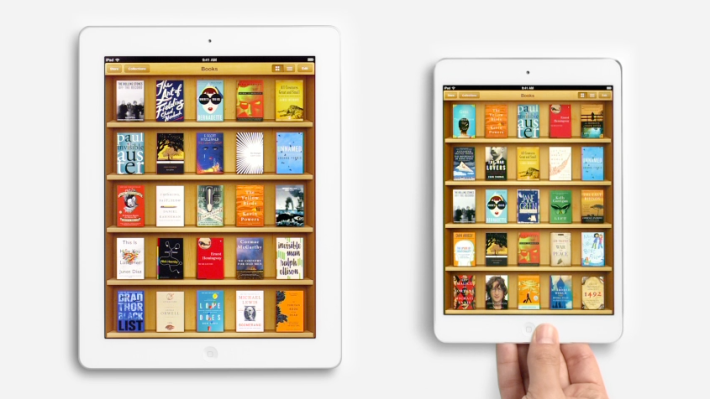The PC market is fast shifting into a touchscreen world, and Apple is leading the charge. Some new numbers from the analysts at Canalys note that in Q4 of 2012, one in every three PCs shipped was actually a tablet, and that Apple’s iPad accounted for about half of them, or one in every six PCs shipped.
Canalys senior analyst Tim Coulling tells me that by “tablet,” Canalys means any computing device with screen of seven inches or more. By combining PC and tablet numbers — a logical thing to do, given that many are substituting tablet purchases and usage for PC purchases and usage — Canalys figures that worldwide PC shipments are actually on the rise — up by 12% on last year to 134 million units for the quarter. That’s in contrast to figures from Gartner, which in January noted that Q4 PC shipments were down by 5% on last year — without factoring in tablets.
Adding Apple’s iPad sales to its Mac sales puts it into the lead among PC vendors. The company shipped 27 million PC units in Q4, giving it a 20.1% share of the market. The number-two vendor was HP, whose market share is based on its PC prowess. It shipped 15 million PCs, for an 11.2% share of the market. That let it edge just ahead of Lenovo, which shipped 200,000 fewer units.
Still, Android continues to make inroads. Canalys points out that this is the first quarter where Apple’s iPad has not accounted for more than 50% of all tablets shipped — it was 49%, as it happens, with Android accounting for 46%.
Apple’s savior was the iPad Mini: “Apple timed the launch of the iPad mini well,” writes Pin-Chen Tang, Canalys research analyst. “Its success proves there is a clear demand for pads with smaller screens at a more affordable price. Without the launch, Apple would surely have lost more ground to its competitors.” Indeed, that fact may well encourage Apple to look at more sizes and price points for its iOS devices in the future.
Overall, Canalys points out that the tablet market grew by 75% in Q4 to 46.2 million units, and that full-year shipments were 114.6 million units. Given that trend, Lenovo, which has been making some interesting hybrid models incorporating both touchscreen and keyboard features, could well pull ahead of HP if the latter doesn’t make some significant tablet inroads in the next couple of quarters.
Meanwhile, Samsung is at the other end of the spectrum: its strong performance, placing it into fourth place with 11.7 million units (9% market share) is based mostly on the success of its line of Galaxy Tab tablets. It shipped 7.6 million of these in Q4, a rise of 226%.
Dell, which is hoping for a turnaround as a private company, rounded out the top five. Dell’s reputation “continues to fade,” Canalys writes, resulting in a 19% drop in shipments in the quarter. “A turnaround in fortunes is likely to take years,” they note — so just as well that Dell will not have to answer so quickly to the markets for its performance.
As other analysts have pointed out, Windows 8 has so far had little impact on worldwide PC shipments, and an almost negligible impact on tablets — with only 3% of tablets shipped in the quarter based on Windows 8. That has had a knock-on effect both for Windows and for those who make devices using the OS. “Microsoft’s involvement in the Dell buyout raises eyebrows in the light of its recent aspirations to become a hardware vendor,” Canalys notes. “But it is not likely to solve Dell’s problems as even Microsoft struggles with pads.” Equally difficult was Windows RT, which failed to break even 1 million units at 720,000 shipped. “The outlook for Windows RT appears bleak,” noted Tim Coulling, Canalys senior analyst. He believes the only way out for this is for Microsoft to drastically reduce the licensing price, cutting further into its margins on the product.
Western Europe’s slow economy also continues to weigh things down.
Amazon, selling only tablets and no PCs (yet?), didn’t make the top five but still managed a substantial volume shift. Its shipments were 4.6 million units, almost mirroring Dell’s decline with growth of 18%. With the Kindle Fire now selling in more markets worldwide, it will be interesting to see if Amazon can see a big boost this year or if it will be stymied by Apple and Samsung. For now, international is doing a good enough job to offset some small declines in the U.S., where the launch of the higher-priced Kindle Fire HD not proving to be a runaway success as the initial launch of the Kindle Fire was a year ago.
